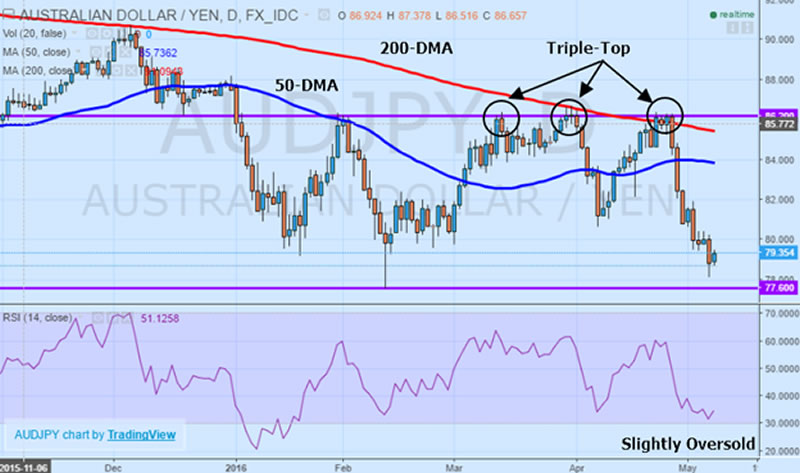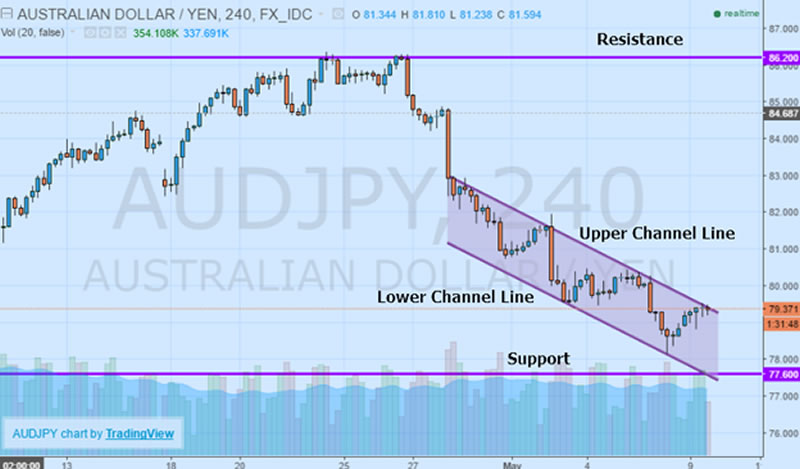Yen Strength Sends AUDJPY Towards Multi-Year Lows
Currencies / Austrailia May 10, 2016 - 03:13 PM GMTBy: AnyOption

 Sustained inaction from the Bank of Japan combined with another round of loosening by the Reserve Bank of Australia has seen the AUDJPY continue to tumble, trending back towards multi-year lows reached back in February during the risk-asset rout. With Central Banks eagerly waiting on the Federal Reserve to act in order to alleviate pressure on local currencies, risk assets are likely to continue tumbling despite the extreme policies implemented by certain institutions. However, with the BoJ not forecast to move on policy short-term and the RBA maintaining its accommodative stance, the stage is set for further losses in the AUDJPY pair as risks to the outlook mount. Barring another round of direction intervention in the Yen from the BoJ, the current trend in the pair is likely to prevail over the medium-term amid worsening external conditions.
Sustained inaction from the Bank of Japan combined with another round of loosening by the Reserve Bank of Australia has seen the AUDJPY continue to tumble, trending back towards multi-year lows reached back in February during the risk-asset rout. With Central Banks eagerly waiting on the Federal Reserve to act in order to alleviate pressure on local currencies, risk assets are likely to continue tumbling despite the extreme policies implemented by certain institutions. However, with the BoJ not forecast to move on policy short-term and the RBA maintaining its accommodative stance, the stage is set for further losses in the AUDJPY pair as risks to the outlook mount. Barring another round of direction intervention in the Yen from the BoJ, the current trend in the pair is likely to prevail over the medium-term amid worsening external conditions.
Policy Response Reaching Limits
As evidenced by the latest choice to punt on further action, the Japanese Central Bank is rapidly running out of tools to fight the persistent force of deflation. Despite slashing interest rates to -0.10% back in January in an effort to spur spending and inflation, neither metric has budged to the upside. Since then, headline consumer prices reportedly contracted at a -0.10% annualized pace in March, printing well below its targeted 2.00%. Additionally, adding to the downside pressure on prices is anemic consumption, with household spending plunging -5.30% year over year through the end of March. Even though conventional wisdom would suggest that negative rates would stimulate spending and inflation, there is no evidence to support this claim based on the data. As a result, the Central Bank has taken to direct interventions in the currency, fighting Yen strength with outright devaluation.
By comparison to Japan, Australian policymakers have been far more deft in their handling of the global deflationary wave. For one, they have substantial room to cut rates from current levels even after reducing the benchmark from 2.00% to 1.75% earlier in the month. Similar to the Yen, Australian officials believe that the Australian dollar remains substantially overvalued. However, unlike Japan, the RBA still has room to accommodate by dropping interest rates to keep inflation close to the target. So far, Australia has been exceptionally effective at insulating against external deflationary forces while maintaining growth, employment, and inflation. Even with the dramatic tumble in commodity prices, the region still has ample tools at its disposal when it comes to tackling any oncoming crisis.
Looking at the fundamental dynamics, there is little reason to believe that the AUDJPY will recover near-term unless the BoJ expands its already ample Quantitative and Qualitative Easing program. Owing to the Central Bank’s extensive footprint in both the government bond market and local equity market, intensifying the ongoing asset purchases will be challenging considering current levels. Even though policymakers are wary of the Yen strengthening to the extent at which that it hurts exporters, the only option left is direct intervention. From the perspective of Australia, the room to ease policy even further is substantial, although might be unnecessary if the Federal Reserve acts. In each central banks’ case, the US Federal Reserve raising rates would effectively diminish the need to act further by helping depreciation both the Yen and Australian dollar. However, that would not impact the current trend in the AUDJPY pair.
Technically Speaking
While there are several factors that are indicating an impending bounce in the AUDJPY pair following the continuation of the downtrend after the recent RBA interest rate announcement, the main bias remains bearish. Even though the relative strength index is trending near the bottom of the range, a suggestion that the pair is slightly oversold, moving averages are acting as resistance against any sustained pullback to the upside. In particular, both the 50 and 200-day moving averages are moving lower over time despite trending above the price action. Additionally, adding to the downward bias is the triple-top that has appeared at 86.200. Coinciding with resistance, this level was also tested back in February and not overcome, indicating an important longer-term level that may continue to prevent any sustained rebound.

Aside from the mostly bearish indicators appearing on the longer-term price action is the emergence of an equidistant channel formation in the shorter-term. The channel, which is trending lower, also has a bearish bias, with ideal positions initiated at the upper channel line targeting the lower channel line for an exit. Although the downward bias is supported by numerous technical indicators and fundamentals, should AUDJPY manage a candlestick close above the upper channel line it is currently trading near, it could suggest an upside breakout. In this case, a breakout would be confirmed by increased directional momentum and above average trading volumes. However, barring a breakout, the key level to watch on the downside is support at multi-year lows of 77.600. A move below this level would pave the way for further losses in the AUDJPY pair.

To Conclude
Looking forward, with few changes expected in fundamental conditions besides additional accommodation, the current downtrend in the AUDJPY is unlikely to experience a substantial reversal. Just as the BoJ runs short of options, the RBA still has ample room to ease policy in an effort to see the Australian dollar depreciate further. As such, even with the risk of a direct intervention in exchange rates by the BoJ, the prevailing downtrend in unlikely to let up, especially if support at 77.600 is broken. Aside from the moving averages, shorter-term patterns are also suggesting that the AUDJPY has further room to run to the downside. Any intervention designed to weaken the Yen might be an opportune time to fade the AUDJPY pair and take advantage of ongoing fundamental and technical trends.
Anyoption™ is the world's leading binary options trading platform. Founded in 2008, anyoption was the first financial trading platform that made it possible for anyone to invest and profit from the global stock market through trading binary options.
Our goal here at Market Oracle is to provide readers with valued insights and opinions on market events and the stories that surround them.
Website anyoption.com
© 2016 Copyright Anyoption - All Rights Reserved
Disclaimer: The above is a matter of opinion provided for general information purposes only and is not intended as investment advice. Information and analysis above are derived from sources and utilising methods believed to be reliable, but we cannot accept responsibility for any losses you may incur as a result of this analysis. Individuals should consult with their personal financial advisors.
© 2005-2022 http://www.MarketOracle.co.uk - The Market Oracle is a FREE Daily Financial Markets Analysis & Forecasting online publication.


